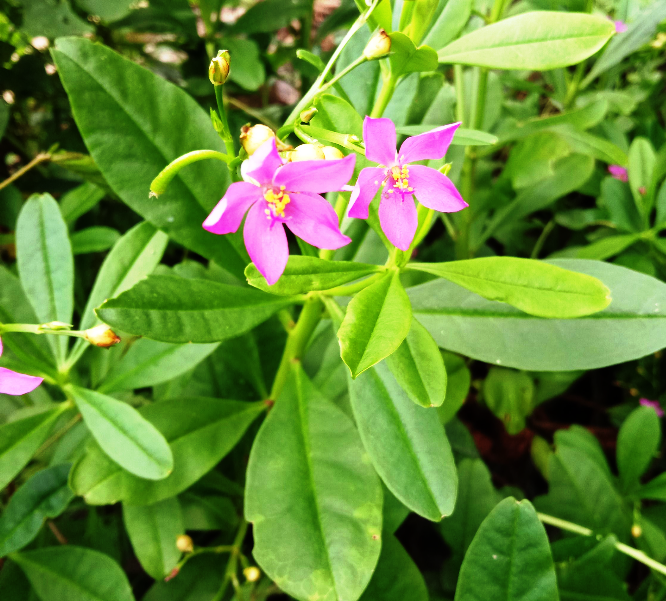Talinum triangulare

|
|
Talinum triangulare Common Names: Waterleaf, Ceylon spinach, fame flower,
Surinam purslane Scientific
Classification Kingdom: Plantae Clade: Tracheophytes Clade: Angiosperms Order: Caryophyllales Family: Talinaceae Genus: Talinum Species: T. triangulare Binomial Name: Talinum triangulare (Jacq.) Willd. Synonyms: Talinum fruticosum (L.) Juss. Morphological Description Talinum triangulare, commonly known as waterleaf, is an erect, herbaceous perennial
plant typically growing to heights of 30–100 cm, though it can reach up to 150
cm under optimal conditions (Kew Science, 2024). The stems are succulent,
fleshy, and often branched, with a smooth, glossy surface that ranges from
green to reddish-purple. Leaves are simple, alternate, and spathulate, 3–10 cm
long and 1–4 cm wide, rounded near the tip and tapering to a wedge-shaped base,
with a thick, juicy texture (Tropical Plants Database, 2024). Flowers are
small, pink to magenta, 1–2 cm in diameter, borne in terminal or axillary
cymes, opening in the afternoon and closing by evening (Swarna et al., 2015).
The fruits are dry, dehiscent capsules, 3–5 mm in diameter, containing numerous
tiny, black seeds with a shiny surface (Burkill, 2000). Distribution and Habitat Native to tropical
regions of Africa, likely West and Central Africa, Talinum triangulare has spread to humid tropical countries
worldwide, including Southeast Asia (e.g., Thailand, Malaysia), South America,
and the Caribbean (Kew Science, 2024). It thrives in a variety of habitats,
such as gardens, farmlands, disturbed areas, and forest edges, preferring
moist, well-drained soils—loamy, sandy, or alluvial—with a pH of 5.5–7.5
(Tropical Plants Database, 2024). The plant adapts to climates with annual
rainfall of 1,000–2,500 mm and temperatures of 20–35°C, growing at elevations
from sea level to 1,000 meters (Burkill, 2000). Its resilience and rapid growth
make it a common weed in cultivated fields. Ethnopharmacology Talinum triangulare is a valued plant in traditional medicine across Africa and
beyond, attributed to its rich phytochemical content, including flavonoids,
phenolic acids, tannins, and polysaccharides.Below are key ethnopharmacological
uses supported by research: · Anti-diabetic Effects: In Nigeria, leaf infusions manage
diabetes; methanolic leaf extracts (250–1,000 mg/kg) reduced blood glucose by
30–40% in streptozotocin-induced diabetic rats, inhibiting α-amylase and
HMG-CoA reductase, key enzymes in carbohydrate and cholesterol metabolism (Olorunnisola
et al., 2022). · Antioxidant Activity: In Ghana, the plant is used to combat
oxidative stress. · Cholesterol-Lowering: In Cameroon, leaves treat hyperlipidemia;
extracts (500 mg/kg) lowered serum LDL-cholesterol by 35% and triglycerides by
28% in hypercholesterolemic rats, enhancing HDL levels (Olorunnisola et al.,
2022). · Anti-inflammatory and Fever Relief: In Togo, leaf decoctions reduce fever and
inflammation; aqueous extracts (200 mg/kg) decreased carrageenan-induced paw
edema in rats by 40%, attributed to flavonoids (Liang et al., 2011). · Antimicrobial Properties: In Benin, leaf juice treats infections;
methanol extracts exhibited an MIC of 125 μg/mL against Escherichia coli, supporting wound-healing claims (Adefegha
& Oboh, 2011). These uses are bolstered
by its nutrient richness, including vitamins C and E, and minerals like calcium
and magnesium, enhancing its health benefits (Ezekwe et al., 2013). ⚠ Toxicity Profile: No significant toxicity is reported for Talinum triangulare when consumed as food or in traditional
doses. Acute toxicity studies in rats showed no mortality at 5,000 mg/kg of
leaf extract, with only mild sedation at high doses (Ikewuchi et al., 2022).
However, its oxalate content may pose a risk of kidney stone formation if
overconsumed, warranting use under guidance (Tropical Plants Database, 2024). Additional Uses · Culinary Applications: Leaves and young shoots, with 3–5% protein
and 20–30 mg/100 g vitamin C, are used in soups, stews, and stir-fries in
Nigeria (e.g., Egusi soup) and Thailand. · Ornamental and Ecological Value: Its attractive pink flowers and lush
foliage make it a garden ornamental, while its rapid growth aids soil
stabilization in disturbed areas (NParks, 2024). · Fodder: In West Africa, it serves as fodder for livestock and
poultry, enhancing egg yolk color due to carotenoids (Burkill, 2000). References
External Links More Pictures |
|
| Compounds of Talinum triangulare |
|
| References |